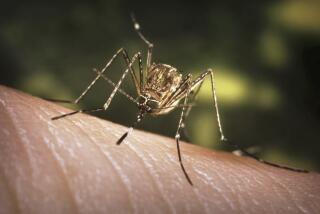O.C. officials delay insecticide spraying to combat West Nile virus

Citing poor weather conditions, Orange County officials have decided to wait until Tuesday to begin spraying targeted neighborhoods in Santa Ana in an attempt to stop the increasing number of residents infected by the West Nile virus.
Officials had originally planned to start spraying for mosquitoes Monday but said that they need more wind and a layer of cold air for the “fogging” to be more effective.
From 3 to 5 a.m. Tuesday through Friday, vector control trucks equipped with foggers will begin spraying four selected neighborhoods in Santa Ana, one on the northeast side of town and the other three on the western side.
“We’re trying to cover as much area as quickly as possible,” said Jared Dever, a spokesman for the county’s vector control district. “One of the final tools in our arsenal is to go to truck-mounted fogging.”
County officials have been particularly alarmed by the amount of mosquitoes infected with the virus this year. On average, 10% to 20% of the mosquito samples collected in Orange County test positive for West Nile. This year, the rate has reached 80%, Dever said.
The number of people infected with the West Nile virus in Orange County this year has increased to 91 as of Thursday, compared with a total of 12 cases in 2013. A Seal Beach woman in her 80s and a Huntington Beach man in his 70s were reported to be the first people in the county to die of the virus this year.
At least nine people have died from the virus in California this year.
The virus is usually transmitted to humans from a bite by an infected mosquito and can cause flu-like symptoms and, in rare instances, death. For most people, the risk of serious illness is low. People 50 or older have the greatest risk of developing serious complications.
Santa Ana was selected as the first city to fog because “they have tested consistently positive for the virus over and over again,” Dever said.
Officials are waiting to see how effective this week’s fogging is before trying it in other hard-hit areas such as Anaheim, Fullerton and Orange.
Mosquitoes become infected with the West Nile virus after feeding on birds with the disease.
Fogging is the only known way to control the population of adult mosquitoes, Dever said. This is the first year county officials have gone to such an extreme in a dense, urban population, he said.
Residents have been instructed to stay inside during fogging and at least half an hour after it. Doors and windows need to be closed and non-recirculating air conditioners shut down until half an hour after the spraying. Pet food bowls and outdoor fish ponds should be covered.
The active ingredient in the pesticide, AquaAnvil, poses a minimal risk to human health and the environment, according to the California Environmental Protection Agency. It will not stain stucco or damage cars or house paint, Dever said. The county has used the fogging trucks routinely on wetlands and other open spaces in the past.
rosanna.xia@latimes.com
More to Read
Start your day right
Sign up for Essential California for news, features and recommendations from the L.A. Times and beyond in your inbox six days a week.
You may occasionally receive promotional content from the Los Angeles Times.







